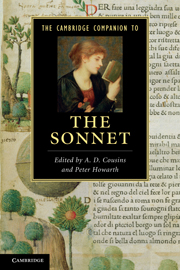Book contents
- Frontmatter
- Introduction
- 1 Contemporary poets and the sonnet
- 2 The sonnet and the lyric mode
- 3 The sonnet, subjectivity and gender
- 4 The English sonnet in manuscript, print and mass media
- 5 European beginnings and transmissions
- 6 Desire, discontent, parody
- 7 Shakespeare’s Sonnets
- 8 Sacred desire, forms of belief
- 9 Survival and change: the sonnet from Milton to the Romantics
- 10 The Romantic sonnet
- 11 The Victorian sonnet
- 12 The modern sonnet
- 13 The contemporary sonnet
- Further reading
- Index
9 - Survival and change: the sonnet from Milton to the Romantics
Published online by Cambridge University Press: 28 May 2011
- Frontmatter
- Introduction
- 1 Contemporary poets and the sonnet
- 2 The sonnet and the lyric mode
- 3 The sonnet, subjectivity and gender
- 4 The English sonnet in manuscript, print and mass media
- 5 European beginnings and transmissions
- 6 Desire, discontent, parody
- 7 Shakespeare’s Sonnets
- 8 Sacred desire, forms of belief
- 9 Survival and change: the sonnet from Milton to the Romantics
- 10 The Romantic sonnet
- 11 The Victorian sonnet
- 12 The modern sonnet
- 13 The contemporary sonnet
- Further reading
- Index
Summary
Received wisdom tells us that from the time of Donne ’s Holy Sonnets in the early 1600s, through to Wordsworth in the early 1800s, the sonnet had been eclipsed, and that here as in other fields we may speak of a Romantic revival. The relatively low esteem granted to Shakespeare ’s Sonnets until Coleridge’s Biographia Literaria seems to confirm the generalization that ‘the sonnet in English had languished as a neglected and decidedly unfashionable form’, and that between Milton and the Romantics, the form ‘appeared to be dead, a defunct and antiquated genre’. 1 However, this chapter will suggest that such generalizations, stemming from the acceptance of some trenchantly expressed literary propaganda perpetrated by Samuel Johnson, are only half true. Neglected and unfashionable, yes, but not dead, defunct or antiquated. In quantity at least, if not always quality, sonnets survived, and by dispensing with the need for a sequence, writers opened up a new opportunity for the ‘occasional’ sonnet. As an indirect consequence, love and fame, the subjects that had dominated the form since Petrarch, were no longer taken for granted. Politics, scenery, moods, special occasions and other topics could act as starting-points and justifications for sonnets. Hence we can trace a steady expansion of the form’s resources away from expressions of praise and unrequited love, and toward the Romantic use of it to express a spectrum of moods: from solitude to sociability, from politics to visions of nature that mirror human states of emotion or ‘inner weather’.
- Type
- Chapter
- Information
- The Cambridge Companion to the Sonnet , pp. 166 - 184Publisher: Cambridge University PressPrint publication year: 2011
- 2
- Cited by



